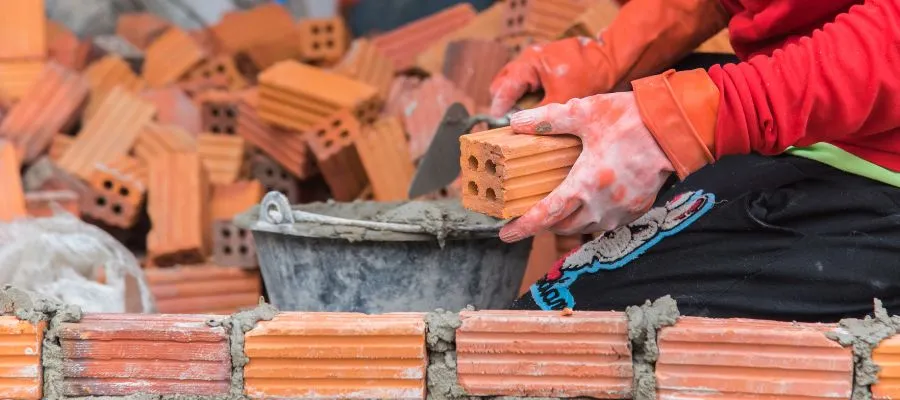Choosing the best building materials is very important when constructing your dream home in India. They should be long-lasting, safe, and look good. Because there are so many choices on the market, choosing the best home construction materials can be hard. In this blog, Brick & Bolt will discuss some of the best building materials for Indian homes, considering temperature, cost, and durability.
Types of Construction Materials For Indian Homes

In India, many types of building materials can be used to meet the requirements and preferences of different people. Here are some types of construction materials that are used in Indian homes:
- Bricks
- Sand
- Concrete
- Cement
- Stone
- Mud & Clay
- Bamboo
- Timber
- Steel & Iron
- Aluminium
- Tiles
- Glass
- Insulation Materials
Bricks:
Indian builders have used bricks for centuries, and for good reason. Various types of bricks are available in the market, including clay bricks and fly ash bricks. Clay bricks are traditional bricks which are long-lasting and won’t catch fire. They also keep heat in very well, which makes them perfect for Indian temperatures. They come in many shapes, sizes, colours, and textures, which lets architects be creative with their designs. Instead of clay bricks, you can use fly ash bricks made from a waste product of coal-fired power plants.
Sand:
Sand is one of the most commonly used building materials in Indian homes. It is often used to make mortar and concrete mixes for floors, walls, and supports of buildings. In addition, sand is used to smooth surfaces, even when filling and finishing different areas. It is easy to find and doesn’t cost much, so it’s a popular choice for affordable house construction materials all over India. It helps make houses that last and look good.
Concrete:
Concrete is one of India’s most useful and widely used building materials. There are various types of concrete available for construction, you can choose the suitable type of concrete according to the type of structure and requirement of structural strength. As a result of its high strength and long life, it can be used for foundations, columns, beams, and different types of slabs, among other structural parts. Adding steel bars or fibres to concrete can make it stronger in tension, allowing it to build tall buildings and structures that can withstand earthquakes.
Cement:
Cement is the binding agent that holds concrete together and plays a crucial role in the construction of Indian homes. Ordinary Portland Cement (OPC) and Portland Pozzolana Cement (PPC) are the most common types of cement used in residential construction, while Rapid Hardening Cement is suitable for projects that require faster setting times. Additionally, Sulphate Resisting Cement is recommended for structures built in areas with a high concentration of sulphates in the soil or groundwater. It is recommended to always choose the most suitable types of cement for your construction project, as cement plays a crucial role in structural strength and integrity.
Stone:
Natural stone has been a popular choice for construction in India due to its durability, beauty, and thermal insulation properties. Granite, sandstone, and limestone are commonly used for flooring, wall cladding, and architectural features like columns and arches. Stone adds a touch of elegance and enhances a building’s structural integrity.
Mud & Clay:
For centuries, mud and clay have been important in building traditional Indian homes. One of the major advantages of mud and clay is that these are eco-friendly and low-cost construction materials. Homes in rural areas are often built with mud and clay found nearby, mixed with water and natural materials like straw or rice husks to make a strong mixture. This mixture is put on wooden frames or bamboo structures to make walls and roofs. In hot climates, it acts as a natural protection and airflow. Even though modern building materials are becoming more common, mud and clay construction methods are still valued in Indian architecture to make eco-friendly homes along with durability, low-cost construction, and cultural importance.
Bamboo:
Bamboo is becoming increasingly popular in India as a long-lasting and flexible construction material. Because it grows quickly, can be used repeatedly, and is strong, it is perfect for many uses, such as roofs, flooring, and different building parts. Bamboo is good for the environment, keeps heat in, and has a natural look that goes well with traditional Indian buildings. As people become more aware of environmental problems, bamboo is becoming more and more popular in Indian homes as a sustainable building material.
Timber:
Wood has been a traditional construction material in India, valued for its strength, insulation properties, and aesthetic appeal. Teak wood, sal wood, and Sheesham wood are popular choices for structural elements like beams, rafters, trusses, doors, windows, and furniture. Engineered wood products offer enhanced strength and dimensional stability, such as laminated veneer lumber (LVL) and glued laminated timber (Glulam).
Steel & Iron:
Steel is an indispensable material in modern construction, known for its high strength-to-weight ratio and ductility. Structural steel is commonly used for columns, beams, trusses, and framing systems, providing a robust and reliable structure. Reinforcing bars (rebar) are made of steel-reinforced concrete structures, improving their tensile strength and overall durability.
Even though steel is now the most common building material, iron is still used extensively in Indian homes, especially for artistic and practical purposes. Wrought iron is often used for elaborate grillwork, railings, and decorative gates, and it also gives any home an elegant and traditional look.
Cast iron is another iron used for hundreds of years in Indian buildings. It is known for having high compressive strength and being resistant to weathering. This makes it a good choice for structural parts like columns and lintels and decorative parts like fences and platforms.
Aluminium:
Aluminium is a lightweight yet durable material that has found widespread use in Indian construction, particularly for doors, windows, and façade systems. It offers excellent corrosion resistance and low maintenance requirements and can be easily customised to suit various design preferences. Aluminium is also energy-efficient, contributing to a building’s overall sustainability.
Tiles:
Tiles are essential in Indian homes, serving both functional and aesthetic purposes. Ceramic tiles are popular as a wall cladding and flooring material due to their durability, ease of maintenance, and wide range of designs and colours. Vitrified tiles are a denser and more scratch-resistant option, making them suitable for high-traffic areas. Natural stone tiles, like marble, granite, and slate, add a touch of luxury and can enhance the overall value of a property.
Glass:
Glass is an increasingly popular material in modern Indian construction, particularly for creating open, airy living spaces. Tempered glass is a safe, durable option for windows, doors, and partitions. At the same time, insulated glass units (IGUs) provide excellent thermal insulation and energy efficiency. Glass can also be used for architectural features like skylights, staircases, and facades, adding a contemporary and sophisticated touch to a home.
Insulation Materials:
Proper insulation is crucial for maintaining a comfortable indoor environment and reducing energy consumption. Expanded Polystyrene (EPS) and Extruded Polystyrene (XPS) are popular building insulation materials used in Indian homes, offering excellent thermal and moisture resistance properties. Additionally, rock wool and glass wool insulation are eco-friendly alternatives that provide effective insulation while being fire-resistant and sound-absorbing.
There are many different building materials available, so when planning your dream home, it’s important to consider cost, durability, energy efficiency, and impact on the environment. For example, you might want to look into Low Cost Home Construction Materials to find budget-friendly yet reliable options.
Our experienced staff at Brick & Bolt can help you through the selection process and help you make choices that are right for your needs and preferences. So, visit Brick & Bolt to learn more about our construction services and their uses. You’ll find information and tools specific to your area.
If you’re ready to start building, our Brick & Bolt cost estimator can help you make a good budget plan by giving you a full breakdown of how much each item will cost.
Our goal at Brick & Bolt is to provide you with the best building materials and expert advice so that your home is not only beautiful but also long-lasting, energy-efficient, and well-built. Contact us now to begin constructing your dream home.

